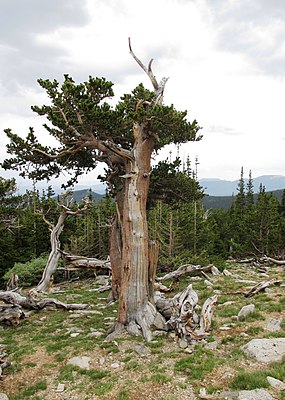Awn pine
| Awn pine | ||||||||||||
|---|---|---|---|---|---|---|---|---|---|---|---|---|

Awn pine ( Pinus aristata ) in Colorado |
||||||||||||
| Systematics | ||||||||||||
|
||||||||||||
| Scientific name | ||||||||||||
| Pinus aristata | ||||||||||||
| Engelm. |
The awns pine ( Pinus aristata ) is a plant from the genus of pine trees ( Pinus ) in the family of Pinaceae (Pinaceae). The long-lived pine ( Pinus longaeva ), formerly regarded as a variety of the awn pine, was separated as a separate species in 1971.
description
The awn pine is an evergreen tree that reaches heights of 8 to 15 meters and trunk diameters of 0.5 to 1 meter. It is very slow growing; sometimes only 3 centimeters will be added in 100 years. Since the closely related Bristlecone Pine ( Pinus longaeva ) was only in 1971 separated from the Bristlecone pine tree as a separate species, is found in the literature still frequently to point out the Bristlecone Pine will about 5000 years old and is thus one of the longest-lived organisms on the earth. After the separation of the Pinus longaeva , to which these age specifications apply, the maximum age of the Grannen Pine “only” has to be given as around 2500 years.
The treetop is narrow and dense with individual protruding, twisted branches. The awn pine has a gnarled, often twisted trunk with a gray to red-brown scaly bark . The resinous buds are 4 mm long and ovate to pointed. The five-needle short shoots are close together. The bark of the branches is densely hairy, initially pale reddish-brown and later gray. The needles of the awning pine are 2 to 4 centimeters long, have noticeable white resin spots and have a lifespan of 12 to 15 years. The needles suddenly end in a short spike tip. The smell of crushed needles is reminiscent of turpentine .
Awn pines in the Front Range of the Rocky Mountains
The awning pine is single sexed ( monoecious ). The flowering period is from July to August. The male cones are about 10 mm long and bluish to red. The female cones are matt purple in the first year and only 2 cm in size; in the second year they are 5 to 9 cm long and 4 cm wide. Each cone scale has a protruding thorn about 6 mm long. The cones of the awn pine also have striking white resin flakes. The mature cones contain 5 mm large, gray-brown to almost black seeds with 1 cm long wings. The seeds ripen in September to October.
The number of chromosomes is 2n = 24.
Occurrence
The Common Pine is native to western North America in the mountains of California , Arizona , New Mexico, and Colorado . Their locations are dry granite and dolomite slopes at altitudes of 2300 to 3500 meters. There it forms the tree line in sparse stands.
Differentiation from similar species
- The foxtail pine ( Pinus balfouriana ) has slightly longer needles (3.5 to 4 cm) with a fine thorn tip; it completely lacks the white resin stains. In addition, the grated needles of the foxtail pine give off a sweet resinous scent.
- The long-lived pine ( Pinus longaeva ) also has slightly longer needles; it also has shorter thorns on the cone scales. This type of pine also has no white resin stains on its needles and cones.
Systematics
Pinus aristata was published in 1862 by George Engelmann in the magazine "The American journal of science and arts", ser. 2, Volume 34, Page 331. A synonym is Pinus balfouriana subsp. aristata (Engelm.) Engelm.
swell
Individual evidence
- ↑ Description and classification of the species in The Gymnosperm Database. (English)
- ^ Tropicos. [1]
- ↑ Rafaël Govaerts (ed.): Pinus. In: World Checklist of Selected Plant Families (WCSP) - The Board of Trustees of the Royal Botanic Gardens, Kew . Retrieved April 22, 2019.
Web links
- Short description of the species. ( Memento from June 16, 2007 in the Internet Archive )
- Description and natural location.
- Pinus aristata in the endangered Red List species the IUCN 2006. Posted by: Conifer Specialist Group, 1998. Retrieved on 11 May, 2006.



